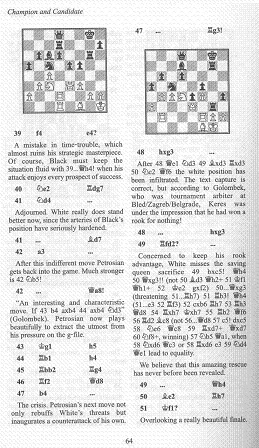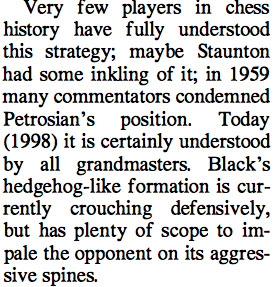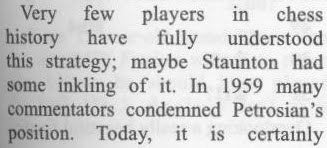This post is largely courtesy of a reader's comment on our post last Friday
which comment, as you see, drew our attention to possible similarities between the notes in Ray and Julian's 2006 Batsford book Petrosian vs the Elite
and the 1975 Batsford book edited by Ray, Learn from The Grandmasters.
We don't have the 1975 volume (which is available here) but we do have the New Algebraic Edition, which was first issued in 1998.
So, here from the 2006 book (page 63) is "the long passage starting with '..we reach a fascinating position'"
and here from the earlier book (page 92) is the same passage.
When I say "the same passage", I mean "the same passage". The 2006 book does, indeed, "lift wholesale" from the earlier one. Wholesale and practically word-for-word.
When I say "practically", I can see "fine" in 2006 and "OK" in the earlier work. Other than that, all I can detect by way of difference is this small section:
from which the incriminating part - that is, the date - has been excised.
I wonder what it said in the 1975 edition?
I wonder, also, whether anything else has been lifted wholesale...
Let's have a look. Here's the game as annotated in Learn from The Grandmasters.
Here's the game as annotated in Petrosian vs the Elite.
To save you the trouble, all the notes (with a very small number of very small alterations) are lifted wholesale from the earlier book into the 2006 one.
There are two exceptions, one being the very long discussion of medieval Arabic chess in the note to Black's thirtieth (which occupies almost two pages of the earlier book but was omitted in 2006) and the other being the note to White's forty-ninth.
But apart from this amazing rescue, which apparently* has never before been revealed, more than two dozen other notes are identical, or near-identical, in both books.
Outrageous? But wait! Ray - on page 13, in his foreword - has an explanation!
So in this case, despite the deconstruction and re-analysis, the only improvement they were able to make was on White's move forty-nine. How extraordinary. That must make Ray's earlier analysis of Keres-Petrosian one of the most remarkable of all time. As well as one of the most remarkably written, given how little needed changing.
Presumably this also explains why there's nothing in Petrosian vs The Elite to say, for instance, "analysis and annotations previously appeared in Learn From The Grandmasters", as Ray knows perfectly well there should if he's not selling goods under false pretenses.
Then, there's Ray's Sunday Times column of 25 August 2013
in which there is nothing to say that the notes are taken from Petrosian vs The Elite or Learn From The Grandmasters. Nor indeed is there any sign of the "amazing rescue", the "astounding sacrifice, overlooked for almost five decades"
from Julian Simpole's foreword (p. 19)
to Petrosian vs The Elite
which you thought Ray would have put in - had he had any other intention than just copying and pasting a few notes
and had either the Sunday Times piece or Petrosian vs The Elite been anything other than an exercise in recycling old work and cheating the public.
Still, I'll say this for Ray, he always makes me laugh. Here he is, later on page 13:
Assiduously avoided duplicating. That's Ray's motto. They could put it on his gravestone.
- - - - - - - - -
So we can now compare the three different versions of the "certainly understood" paragraph.
1975
1998
2006
Of course it's perfectly proper to change the text from one edition or one book to another - matter of fact, it's what you're supposed to do. It's the rest of the text that's the problem.
[Thanks to PGF, Angus French and Pablo Byrne]
[Ray copies Ray index]
[Ray Keene index]





.PNG)





















+108109.PNG)
+110111.bmp)
+112113.bmp)
+114115.bmp)




5 comments:
I don't suppose anybody's got a copy of Ray's "Complete Book of Beginning Chess"? I know the game's in there, and I'm keen to know what notes are employed...
Whether the comment about "understood by all grandmasters" appears in the 1975 edition is an interesting illustration of development of chess thought. Kasparov mentions the development and acceptance of Hedgehog strategies as part of a 70s Revolution, so I don't know whether Ray would have felt able to make that comment as early as 1975. The 1998 edition of "Learn" wasn't just an algebraic version of the 1975 book, didn't it have some new material?
RdC
I dunno Roger. I'm rather hoping one of our aged and learned readers could tell us. Personally, I'd not even heard of Ray Keene in 1975...
On pages 111-112 of the original Learn from the Grandmasters, the note appears almost exactly as the algebraic edition except for the final sentence. This was originally:
"Today it is certainly understood by such grandmasters as Ljubojevic and Andersson and is now recognized as a valuable strategic device, enriching our understanding of the profound game of chess."
And we might add, written in classic Keeneish verbosity.
Looking on the bright side, I can only imagine that Ray's recent output for the Times and Spectator has seen our scribe at his creative best.
Post a Comment